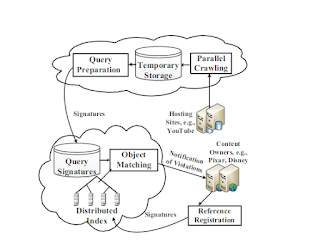Abstract
We
propose a new design for large-scale multimedia content protection systems. Our
design leverages cloud infrastructures to provide cost efficiency, rapid
deployment, scalability, and elasticity to accommodate varying workloads. The
proposed system can be used to protect different multimedia content types,
including 2D videos, 3D videos, images, audio clips, songs, and music clips.
The system can be deployed on private and/or public clouds. Our system has two
novel components: (i) method to create signatures of 3D videos, and (ii)
distributed matching engine for multimedia objects. The signature method
creates robust and representative signatures of 3D videos that capture the
depth signals in these videos and it is computationally efficient to compute
and compare as well as it requires small storage. The distributed matching
engine achieves high scalability and it is designed to support different
multimedia objects. We implemented the proposed system and deployed it on two
clouds: Amazon cloud and our private cloud. Our experiments with more than
11,000 3D videos and 1 million images show the high accuracy and scalability of
the proposed system. In addition, we compared our system to the protection
system used by YouTube and our results show that the YouTube protection system
fails to detect most copies of 3D videos, while our system detects more than
98% of them. This comparison shows the need for the proposed 3D signature
method, since the state-of-the-art commercial system was not able to handle 3D
videos.
Aim
The
main aim of this paper is to provide cost efficiency, rapid deployment,
scalability, and elasticity to accommodate varying workloads
Scope
The
scope of this paper shows the need for the proposed 3D signature method, since
the state-of-the-art commercial system was not able to handle 3D videos.
Existing System
The
problem of protecting various types of multimedia content has attracted
significant attention from academia and industry. One approach to this problem
is using watermarking, in which some distinctive information is embedded in the
content itself and a method is used to search for this information in order to
verify the authenticity of the content. Watermarking requires inserting
watermarks in the multimedia objects before releasing them as well as
mechanisms/systems to find objects and verify the existence of correct
watermarks in them. Thus, this approach may not be suitable for
already-released content without watermarks in them. The watermarking approach
is more suitable for the somewhat controlled environments, such as distribution
of multimedia content on DVDs or using special sites and custom players.
Watermarking may not be effective for the rapidly increasing online videos,
especially those uploaded to sites such as YouTube and played back by any video
player. Watermarking is not the focus of this paper.
Disadvantages
· Illegally
redistributing multimedia content over the Internet can result in significant
loss of revenues for content
· Finding
illegally-made copies over the Internet is a complex and computationally
expensive operation
Proposed
System
The goal of the proposed system for
multimedia content protection is to find illegally made copies of multimedia
objects over the Internet. In general, systems for multimedia content protection
are large-scale and complex with multiple involved parties. In this section, we
start by identifying the design goals for such systems and our approaches to
achieve them. Then, we present the high-level architecture and operation of our
proposed system.
Advantages
- Accuracy
- Computational Efficiency
- Scalability and Reliability
- Cost Efficiency
System Architecture
System
Configuration
Hardware Requirements
- Speed - 1.1 Ghz
- Processor - Pentium IV
- RAM - 512 MB (min)
- Hard Disk - 40 GB
- Key Board - Standard Windows Keyboard
- Mouse - Two or Three Button Mouse
- Monitor - LCD/LED
Software
requirements
- Operating System : Windows 7
- Front End : ASP.Net and C#
- Database : MSSQL
- Tool : Microsoft Visual studio
References
ElGamal, T. Calagari, K.
Abdelsadek, A. Hefeeda, M. “Cloud-Based Multimedia Content Protection
System” IEEE Transactions on Multimedia, Volume 17, ssue 3
JANUARY 2015.

No comments:
Post a Comment